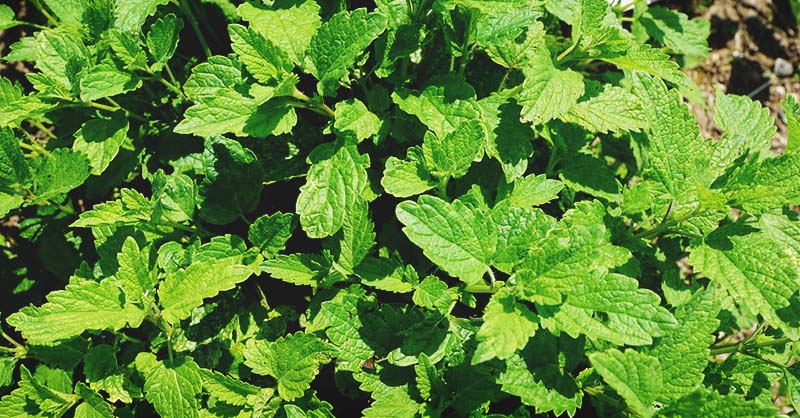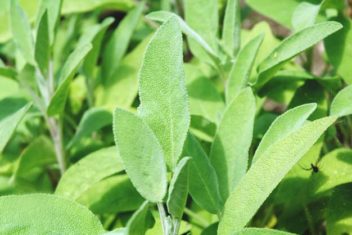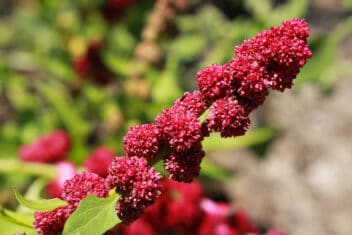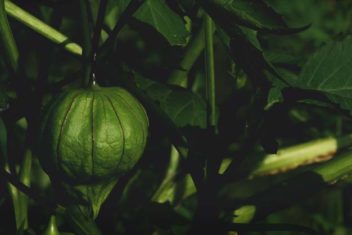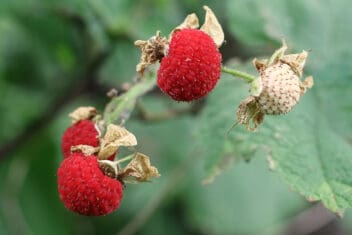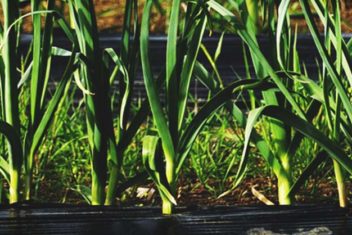Lemon verbena is an aromatic herb with fragrant leaves that fill the garden with a sweet, lemony scent. Not only does the plant smell and taste delicious, but it’s beautiful in landscaping, forming a large shrub with rich, green leaves and delicate white to purple blossoms.
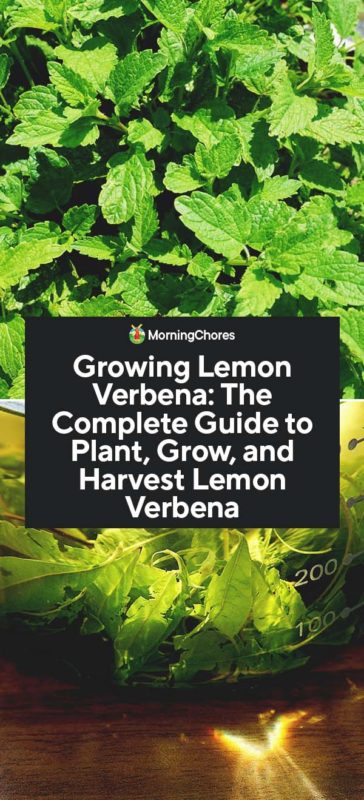
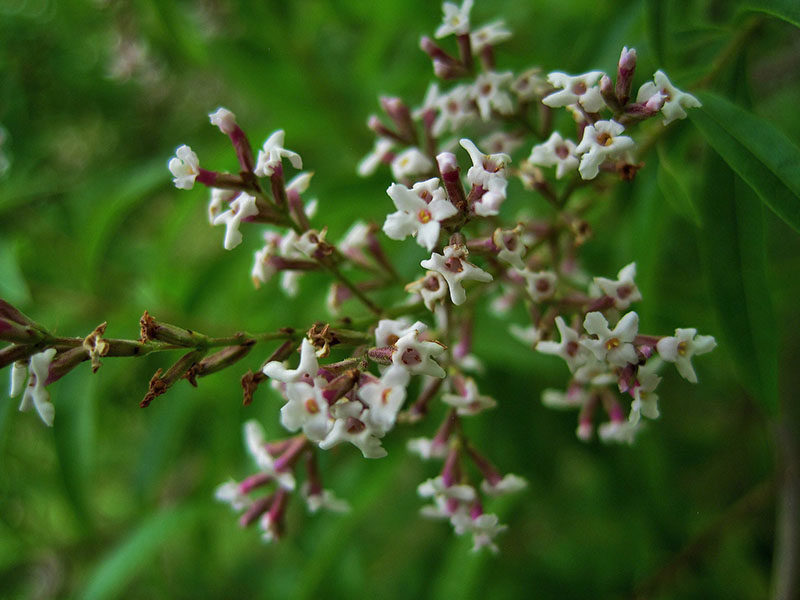
Given all its positive attributes, it’s no wonder that more and more gardeners are rediscovering this herb and want to learn all about growing lemon verbena!
Lemon verbena has a long medicinal and culinary history. Victorian ladies would stuff sachets with the lemony leaves for a fresh scent during the sweltering days of summer. These days, you’ll find it in tea, soaps, beverages, and desserts. Innovative cooks even use the leaves to flavor meats and fish.
Growing up, I remember the lemon verbena shrub that my grandmother grew in her garden. It was taller than me, and I used to run my hands through the leaves, releasing a burst of fragrance. Citrusy scent flew through the air, and I liked to steal a few leaves to sniff as I played in the yard.
Planting Lemon Verbena
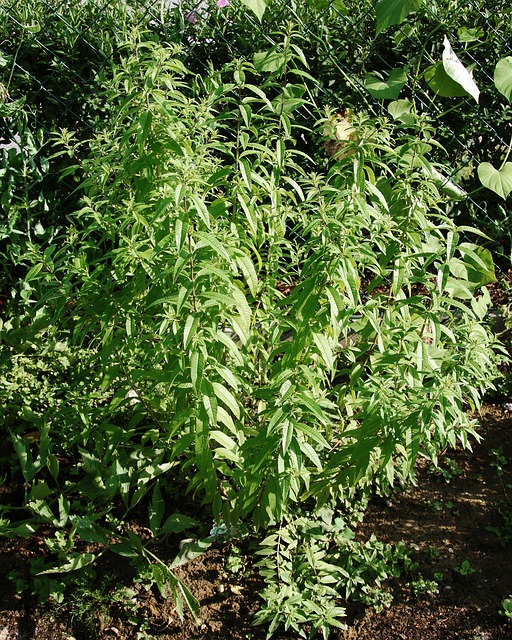
Growing Zones
Lemon verbena is a perennial in frost-free areas like zone 9 and 10. If you live in a zone with cold winters, you can try growing lemon verbena in a container, keeping it indoors during the cold times. You can also grow it as an annual in zones 7 and below.
Sun Requirements
Lemon verbena grows best in full sunlight. Full sun gives the best growth and the most flavorful leaves, but if you live in a desert region or the southernmost states, it’s best if your plants have some light afternoon shade to protect them from the scorching sun.
If you live in northern areas, putting your plants near a fence or a white wall to help reflect light, which will enhance growth.
Too much shade will cause the stems to be sprawling and spindly, and the leaves won’t have intense oil levels.
If you’re growing lemon verbena inside, pick a place in your house that is one to two feet from a sunny window. You also can place it under full-spectrum light.
Soil Requirements
Lemon verbena prefers loose, well-draining soil that is rich in organic matter. It’s essential to make sure that the plant has plenty of drainage, which is the key to success. The roots will die if they stay constantly wet.
You can add compost, sand, or peat moss to the soil to help increase drainage.
Starting Lemon Verbena
In most circumstances, gardeners start with a purchased plant or a stem tip cutting from a friend. Either way, you want to plant your lemon verbena in spring.
You can start lemon verbena from seed, but it’s not for the weak of heart. It’s a challenging plant to start, and slow to germinate and grow. It takes a long time, and most people prefer to go with a purchased plant.
If you go with the seed route, plant seeds outside after the danger of frost has passed.
If you decide to grow a cutting, moisten and put the cutting into the soil. Then, put a plastic bag over the pot, creating a mini-greenhouse environment. Then, once the plant takes root, you can switch to the plant to a container with high-quality potting soil to help renewed leaf growth.
Spacing
Pick a place roomy spot to plant your herb. Each shrub needs to be at least 12 inches apart, and the rows need to have an 18-inch gap between the plants. Lemon verbena are large plants that need space to grow. Annuals can be grown in a smaller spot.
Dig a hole a bit wider and deeper than the pot the plant is currently in and set it in the hole. Pat down firmly on the dirt and water deeply.
Growing Lemon Verbena in Containers
If you decide to make a go of growing lemon verbena in a container, pick a pot that is at least 12 inches in diameter so that the roots have room to spread out and grow.
Choose a larger pot because it insulates the roots against soil temperature changes. Some gardeners bury the container in the ground to provide more root insulation.
Use a premium potting mix to fill the pot. Amend store-bought soil with coarse sand and peat moss.
How to Care for Lemon Verbena
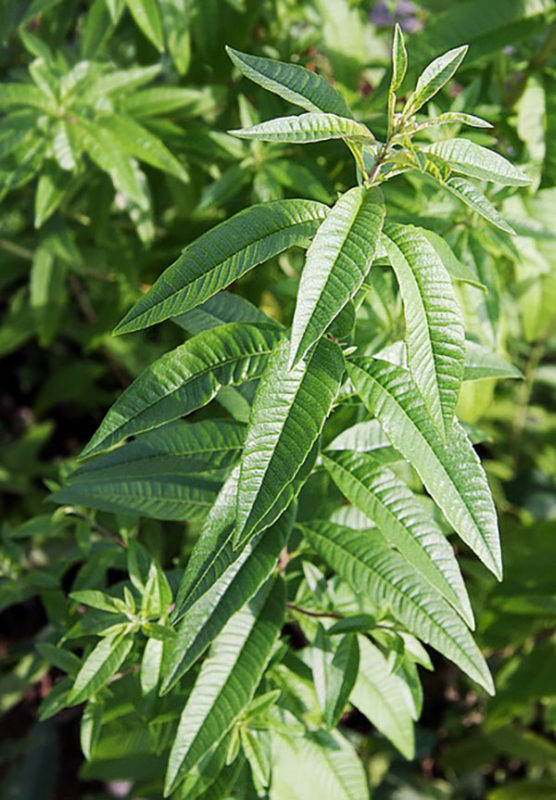
Taking care of lemon verbena requires a few extra steps because they are heavy feeders and prolific growers.
Watering
Remember when you’re growing lemon verbena, you need to water on an regular basis. However, you don’t want to make the roots wet all of the time. Soaking the roots in standing water will cause the plants to die. Water the plant when the top 2-3 inches of the soil has dried. In most areas, this translates to 1 inch of water per week.
Fertilizing
Lemon verbena is a heavy feeder, so it benefits from frequent fertilization, unlike other herbs. You can add some fertilizer in the early spring and throughout the growing season. Usually, a vegetable fertilizer, such as a 5-10-10 or a 10-10-10 granular fertilizer works fine.
When the plant is actively growing in a container, fertilize with an organic, water-soluble fertilizer every two weeks from spring to fall. Remember this herb feeds often!
Pruning
This herb needs regular pruning to stop a build-up of deadwood and a straggly look. Prune your growing lemon verbena regularly to accelerate new growth.
When you prune, make sure you remove any dead wood first. Spring pruning will help to contain the growth, while other prunings throughout the year help to keep the plant looking tidy. You can save the clippings to start new plants or just use them up in the kitchen.
Overwintering Lemon Verbena
When the temperatures dip below 40℉, lemon verbena drops its leaves and enters dormancy. You can overwinter this plant outdoors in USDA zones 8 and warmer, but you should harden off the plant first. To harden off, reduce watering a few weeks before the typical onset of below-freezing temperatures.
If you live in colder zones, bring the plants indoors before the cold weather arrives, or you can wait until a cold snap causes the plant to drop leaves. Avoid overwatering dormant and leafless plants. It is an easy way to kill your lemon verbena, whether they’re in your garden beds or a container.
Companion Plants for Lemon Verbena
The best companions for lemon verbena include:
- Lemon grass
- Alfalfa
- Apple
- Apricot
- Bee balm
Common Pests and Diseases
One problem with lemon verbena is that it can be a host of dozens of pests. Depending on where you live, the pests and diseases can vary. Here are a few of the common ones.
Leafminers
If you notice a small black or grey fly with a yellow stripe and transparent wings, you have leafminers. Leafminers lay their eggs on the underside of the leaves where they feed on the leaf tissue. You’ll often notice the maze-like tunnels they chew through leaves, first.
Try introducing beneficial predator insects such as ladybugs to your garden to take on the leafminers. Also, be sure to use proper plant care techniques and remove infected leaves to stop the infestation.
Mites
Spider mites are red, yellow, or green pests that size of a pinhead that causes webbing on the leaves. Their size makes them a bit tricky to spot!
Large infestations of mites can cause yellow, withered leaves that drop prematurely. Using insecticidal soaps and oils helps to get rid of spider mites.
Aphids
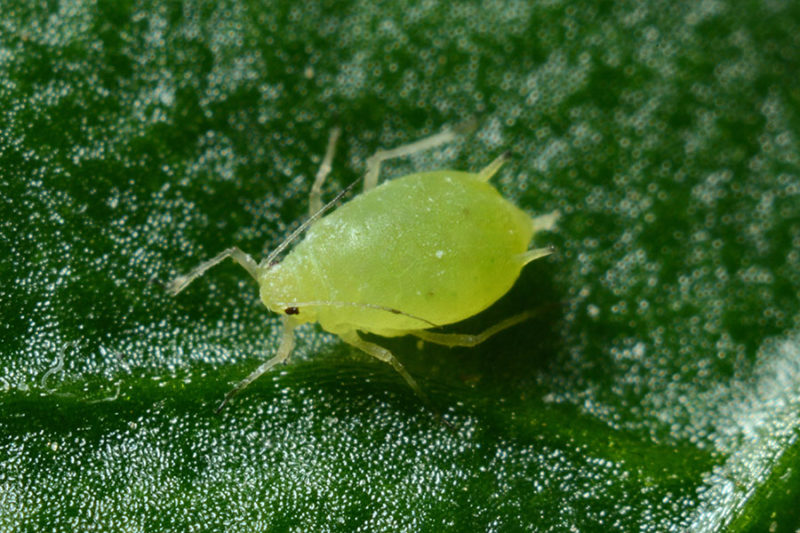
Aphids are tiny, soft-bodied insects that cover the buds and underside of the leaves. The problem is aphids is that they suck the plant’s fluid by piercing stems and leaves with their mouths.
A small infestation of aphids doesn’t pose a huge problem, but a more extensive infestation can stunt growth and encourage powdery mildew growth.
Treat aphids by blasting them off of the plant with water and apply insecticidal soap. Beneficial predator insects also help to feed on the aphids.
Scale
If you notice tiny, brown bumps on the leaves that seem to move, you have a scale infestation. Scale is a parasitic insect that feeds on the sap of the plant, leading to defoliation and branch dieback. You can treat the plant with insecticidal soap or horticultural oil.
Harvesting and Storing Lemon Verbena
The great thing about harvesting lemon verbena is that you can do it as often as you want throughout the growing season. Each time you cut a new stem, new growth will emergy at the whorl of leaves under the cut. The growth pattern means that frequent cutting is necessary to stop the stems from becoming too leggy.
You can make a large cutting by removing half of the plant off. If your plant is a bit out of hand, removing more keeps the plant contained.
To store your lemon verbena, dry the leaves individually on screens or bundle the stems together and hang upside down in a dark, dry location. Then, save the dried leaves in sealed containers in a dark place. When you’re ready, crumble the leaves up before using.
Another choice is to freeze lemon verbena, whole or chopped, in ice cube trays filled with water. Try blending the chopped leaves with softened butter and store in an airtight container in the refrigerator for a unique butter flavor.
Cooking with Lemon Verbena
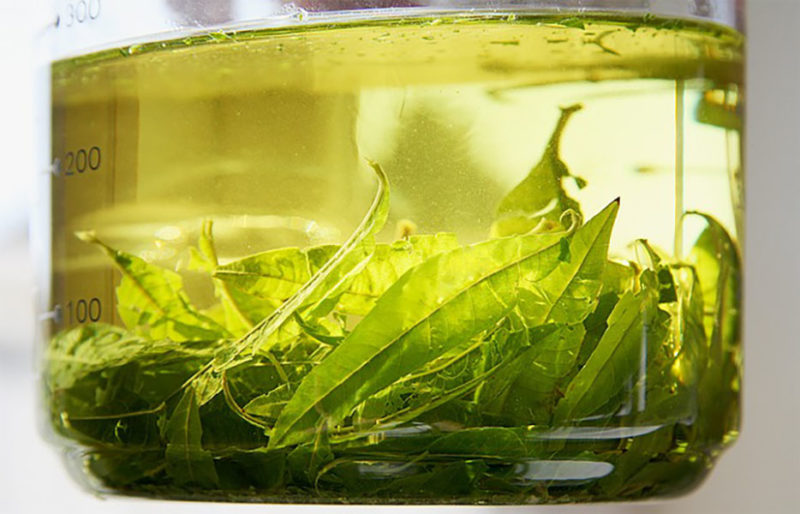
Many people don’t realize how versatile lemon verbena is in the kitchen. At the end of the growing season, take any unused leaves and put them into grapeseed oil. Blend the mix in a blender and let it sit for a few hours. Then, mash and strain the solids. Use the lemon verbena-infused oil in salad dressings, or pour it over veggies.
Lemon verbena makes a dreamy ice cream, tastes great in shortbread, lends itself nicely to custard, and makes pesto shine. Try it as a garnish in your favorite cocktail or use it to add zing to chicken.

Of course, you can always go with the classic: tea. Lemon verbena has been used historically as a tea to reduce indigestion and increase appetite. Whether it works or not, it tastes great. Try it mixed with mint for a special summer iced tea.
The Bottom Line on Lemon Verbena
Lemon verbena is a sizable herb that makes a statement in your landscaping. It’s aromatic, so you want to place it somewhere that people will see and smell it. You can’t fully appreciate lemon verbena without a frequent whiff of its lovely scent. Whether you add it to your tea or meat seasoning, it’s a versatile herb that everyone loves.

